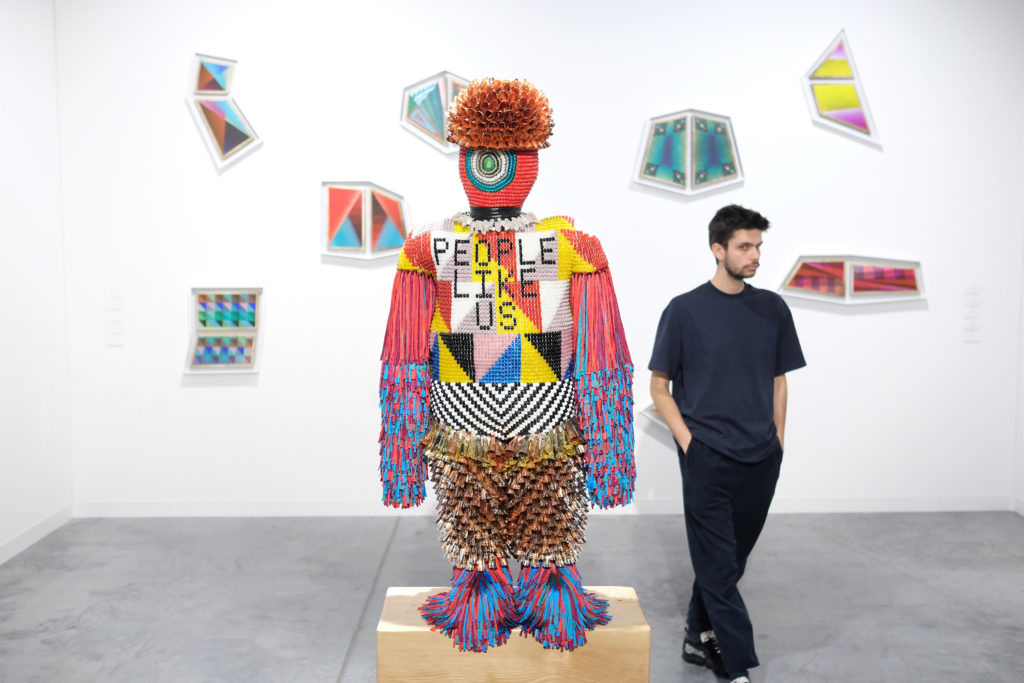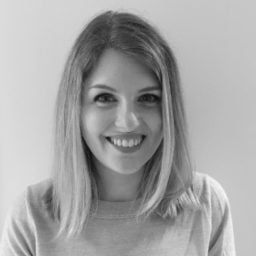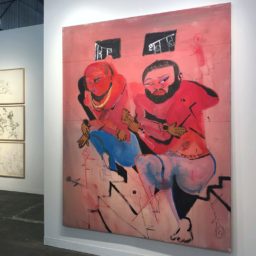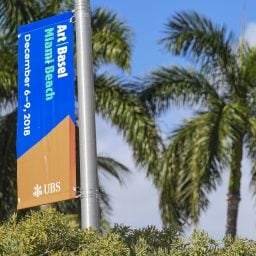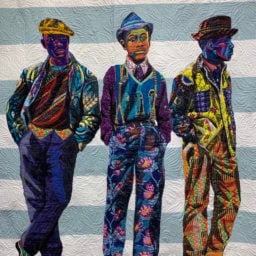Here’s a fun exercise: Visit any art fair, anywhere in the world, and ask a dealer how business is going. The odds are good you will get the same answer every time, no matter what: “It’s going great!” Nevertheless, the tone of pleasant surprise in several dealers’ voices during the VIP preview at Art Basel Miami Beach on Wednesday suggested that, for a fair number of them, business was going well—in fact, better than they expected.
On paper, the forecast looked stormy: Even setting aside the political tumult sweeping the globe and a looming trade war between the US and China, the Dow Jones tumbled almost 800 points the day before the fair—the final major art-market event of the year—opened its doors. And a number of longtime regulars had said they didn’t plan to fly to Miami this year.

Guests attend the Art Basel Miami Beach VIP preview in Miami Beach, Florida. Photo by Nicholas Hunt/Getty Images.
“I had slim to no expectations,” said the dealer Tim Blum of Blum & Poe. But a few hours into the fair, the gallery had sold the majority of the work on its stand, including two muscular abstract paintings by the Dutch artist Karel Appel for €120,000 ($136,000) each and a recent portrait by sought-after American artist Henry Taylor for $325,000.
And although some figures did indeed opt to sit the fair out, the aisles were far from empty. Curator Hans Ulrich Obrist, Guggenheim Museum director Richard Armstrong, local collector Martin Margulies, and artist KAWS—whose $65,000 print triptych was so sought-after that Pace Prints had to conduct a lottery for the edition of 100—were among those spotted at the fair. Regular visitor Leonardo DiCaprio was in attendance as well, seen walking into the booth of David Kordansky with a baseball hat and a hoodie pulled up over his head, along with a small entourage.

Lee Krasner, Bird Image (1963). © 2018 Pollock-Krasner Foundation / Artists Rights Society (ARS), New York. Courtesy of Kasmin Gallery.
Eight-Figure Sales
At least one early sale hit eight figures. Van de Weghe sold a brushy Picasso portrait, Tete de Femme (1971), which was listed at $17 million, within the first few hours. Hauser & Wirth sold a new painting by Mark Bradford to a collector who has promised it to an American institution for a list price of $5 million and Philip Guston’s Shoe Head (1976) for $7.6 million, which hasn’t been shown since the year it was made.
Paul Kasmin Gallery, meanwhile, swiftly sold an orange and maroon abstract work by Lee Krasner, Bird Image (1963), priced at $3.6 million, as well as a lively 1986 interior by William N. Copley, Why Are You Staring (1986), for $300,000, among other works. “It’s as good as any first three hours of a fair we’ve ever had,” said gallery director Eric Gleason.
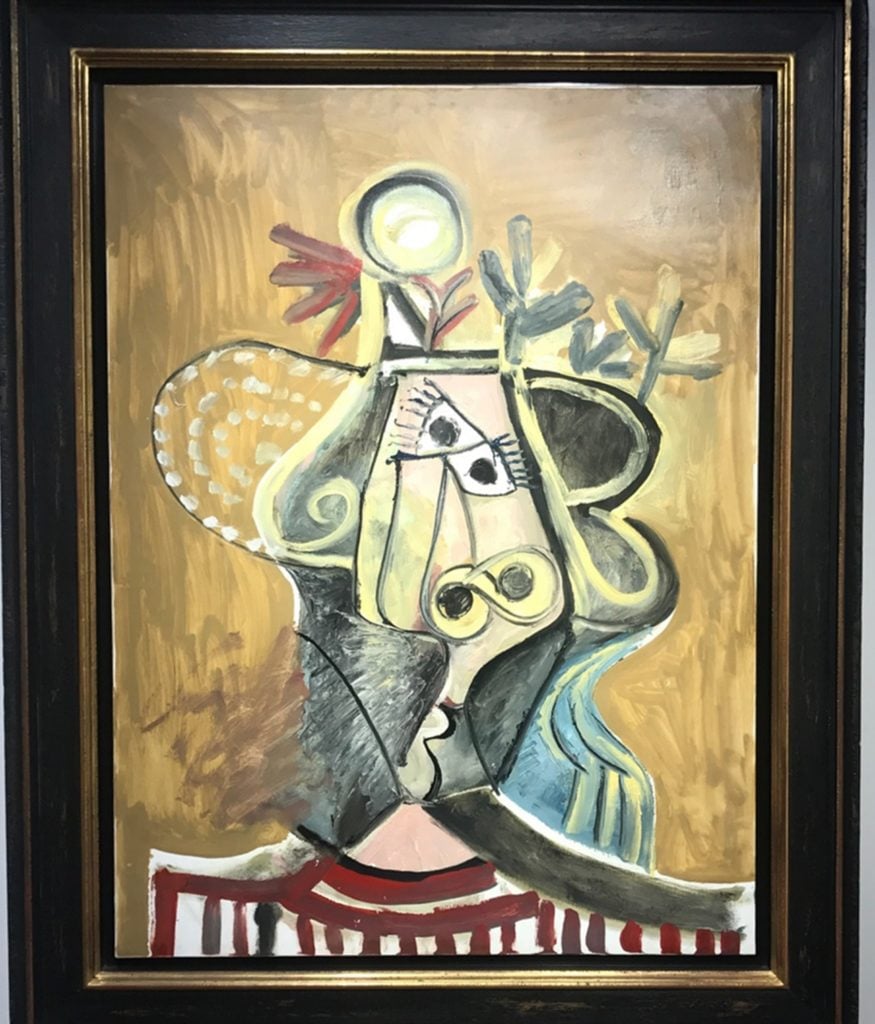
Pablo Picasso’s Tete de Femme (1971) at Van de Weghe’s booth. Photo: Julia Halperin.
Perhaps the most expensive work at the fair was Mark Rothko’s Untitled (Yellow, Orange, Yellow, Light Orange) (1955) at the booth of Helly Nahmad Gallery. The painting, which was owned for more than 40 years by Paul and Rachel Mellon before it sold at Sotheby’s in 2014 for $36.6 million, is now on offer for $50 million. It was still available as of Wednesday afternoon.
Much of the work to sell early and often was, unsurprisingly, painting. Early sales included Red Hat (Nicole) (2013) by Alex Katz at Richard Gray Gallery for $500,000 and a painting by the rising Belgian artist Harold Ancart for $150,000 at David Zwirner. On the slightly less practical end of the spectrum, Pace Gallery sold a light box by Mary Corse for $180,000 and Andrew Kreps sold a magical and worrying tapestry by Goshka Macuga, designed to be viewed through 3D glasses, which presents polar bears wandering through a forest with no snow in sight for €90,000 ($102,100).

Installation view of Goshka Macuga, Make Tofu Not War (2018). Courtesy of the artist and Andrew Kreps Gallery, New York.
Museums were also doing some buying. Kohn Gallery sold a painting by the 28-year-old rising star Jonathan Lyndon Chase to the Los Angeles County Museum of Art and two collaged works by the Colombia-born, Brooklyn-based artist Maria Berrio, including one to a New York museum.
For many dealers, this opening day was a pleasant surprise after a few more challenging years in Miami. “Last year was quieter, the year before that was the year of Zika, the year before that was torrential rain—I think they worked hard to make sure people came,” one dealer said.
Rebounding From a Difficult Year
This year also marks the first fair in the fully revamped Miami Convention Center, which last year was in the midst of a $620 million facelift. As a result of construction delays and damage from Hurricane Irma, certain entrances were closed unexpectedly—a seemingly mundane detail that can in fact have a major impact by marooning dealers in a remote section of the floor. As a result, the fair confirmed to artnet News, it issued proactive discounts to dealers who would be most affected.
But a number of dealers found the setup to be worse than they imagined, and banded together after the fair to write a letter expressing their extreme dissatisfaction and demanding recompense, artnet News has learned. A spokesperson for the fair confirmed it later “expanded the discount to additional galleries who believed they also experienced slower foot traffic. In the end, 42 exhibitors in the southwest quadrant of the fair received 15 percent off their square meter rate and we also waived the 5 percent premium placement fee for 8 exhibitors in this area. None of the galleries chose not to return to this year’s show as a result.”
This year, the building was finished and the mood, considerably peppier. Dealer Sean Kelly said he knew the fair would be a success before he even set foot in the booth. The gallery sent out a PDF of the works it planned to bring to Miami five days ago, and sold half of what was on the stand in advance. “We had the biggest advance sales of any fair we’ve ever done,” he said.

Idris Khan’s Still, Beneath a Pillow (2018), part of Sean Kelly’s “Collect Wisely” campaign. Photo: Courtesy of Sean Kelly.
At a time when many malign the polarization in the art market and the dilettantism among collectors, Kelly hatched a plan to make the most of this year’s fair. As part of his ongoing “Collect Wisely” campaign, which seeks to develop shoppers into dedicated collectors, he has set up a comfortable chair on a slightly raised platform facing a work of art like a television set. (The work will be rotated out daily; the first one was a gray-toned print by Idris Khan priced at £65,000.) One at a time, fairgoers are invited to sit in the chair, put on a pair of headphones, and listen to the artist speak about the work, their process, and their inspiration for several minutes.
“Everyone running around is so busy, we wanted to create a moment of respite,” Kelly said. Of course, this is still an art fair, after all. Does he think the works will sell better after people have been engineered into intimate communion with them? “Of course,” he replied.
Additional reporting by Eileen Kinsella
UPDATE: A previous version of this article mentioned that the artist Richard Prince was spotted at the fair. It was, in fact, an extremely convincing doppelgänger.
